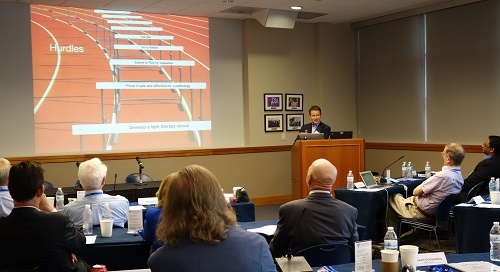Photobiomodulation – Overcoming the Hurdles
Johnathan George
Photobiomodulation in Opthalmology
Clark Tedford, Ph.D. and Graham Merry of LumiThera, Inc. kicked off the first of a series of sessions on clinical applications with the use of PBM in ophthalmology for the treatment of patients with Age-related Macular Degeneration (AMD). LumiThera approached the design of their device by looking at the problem from a pharmacological perspective. They selected three wavelengths of light at 590nm, 670nm, and 850nm to target distinct molecular mechanisms. The initial clinical diagnosis of early AMD is based on seeing “Drusen”, that is, deposits of lipids under the retina, in Optical Coherence Tomography (OCT) images of the retina. Dr. Tedford presented OCT images of Drusen before and after treatment of the eye with PBM showing marked reduction in the size of the Drusen. Pending clinical trials, they hope to see their device marketed in Europe by mid-2016 and in the United States shortly after that.
Photobiomodulation and Traumatic Brain Injury
Margaret Naeser Ph.D., Research Professor of Neurology, Boston University School of Medicine, led a session on improving cognitive functions. She discussed one study with PBM applied to traumatic brain injury (TBI). TBI is a major medical problem in the United States with 3 TBIs occurring every minute. Naeser’s study used two LED clusters placed in a stocking cap on subjects’ foreheads to provide transcranial illumination to the frontal lobe. Over time, significant positive linear trends were observed using specific neuropsychological tests. Naeser also presented results of a study of transcranial LEDs used to treat chronic stroke in which they observed negative results when PBM was applied to both sides of the head and positive results when the PBM was applied only to the side of the head where the stroke had caused damage. Naeser continued by discussing the potential for PBM applied along the center front hairline to improve functional connectivity in the Default Mode Network (DMN), a major neural structure in the human brain.
Photobiomodulation and Mental Health
Anita Saltmarche, Saltmarche Health & Associates, continued on this topic with a discussion of preliminary results of a pilot study with transcranial plus intranasal LEDs to improve cognition and quality of life in dementia. In this small, single-blind study the initial results have been positive. The day concluded with a presentation by Paolo Cassano, MD Ph.D., Center for Anxiety and Traumatic Stress Disorders, Department of Psychiatry, Massachusetts General Hospital, Harvard University, on the use of PBM for the treatment of depression. An initial study had to be cut short when the supplier of the LED device, PhotoThera, Inc., went bankrupt in 2013. Fortunately the study has restarted with an Omnilux LED device by PhotoMedex.
Stay tuned for more clinical applications as well as a discussion on how to move forward.

Incubator advisory committee member and sponsor James Carroll, THOR Photomedicine Ltd., kicked off a discussion on the hurdles facing the community and more widespread, proper use of the technology.
